Wooden Bed Frames with Rounded Corners: Design and Benefits

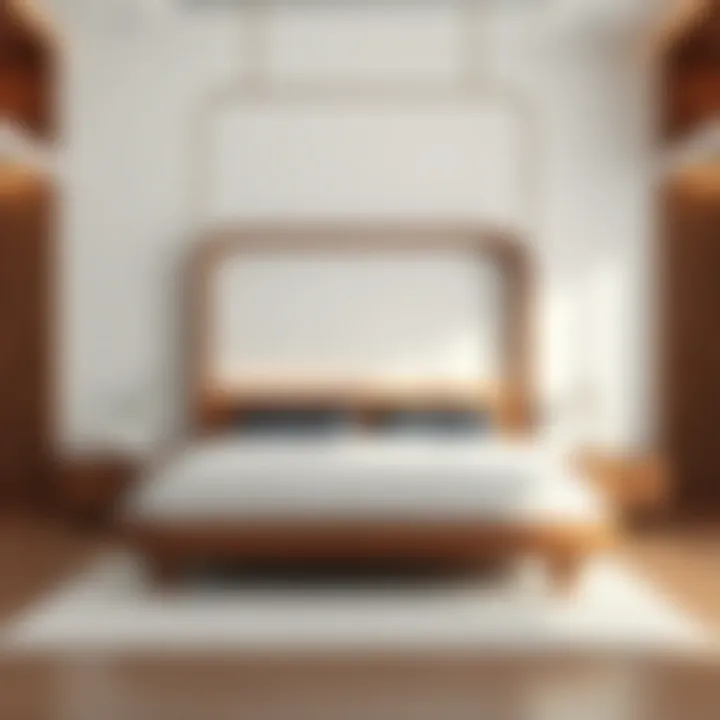
Intro
Wooden bed frames, particularly those designed with rounded corners, have gained significant popularity in recent years. This trend, rooted in both aesthetic appeal and practical functionality, encapsulates a harmonious balance that suits various interior styles. The gentle curves of rounded corners not only soften the visual impact of the furniture but also enhance safety, especially in homes with children or pets. This article aims to explore the intricate nuances of these bed frames, shedding light on their design trends, practical tips for selection and care, and the way they can seamlessly integrate into diverse living spaces.
Furniture Design Trends
Current Styles and Themes
The world of furniture design is continually evolving. Wooden bed frames featuring rounded corners can be found across a spectrum of styles—from minimalist Scandinavian designs, where simplicity reigns, to more elaborate rustic themes that celebrate the beauty of natural wood grains. These frames often evoke a cozy, inviting atmosphere in any bedroom.
For instance, consider a mid-century modern influence that pairs rounded-edged frames with sleek lines and muted colors, creating a calm yet sophisticated ambiance. Alternatively, a bohemian style might incorporate colorful textiles and patterns, with wooden frames serving as a natural contrast, bridging the gap between elegance and whimsy.
Color Palettes and Materials
When it comes to choosing colors and materials, wooden bed frames with rounded corners present endless possibilities. Light woods, like maple or birch, offer a serene and airy feel that can brighten up small spaces or complement a pastel color scheme. On the other hand, darker woods, such as walnut or mahogany, impart a rich, sumptuous look, perfect for creating a master suite that speaks to luxury.
In addition to natural wood finishes, painted frames can also add a pop of color to a room. Pastel paints can soften the look, while bold hues like navy or forest green can make a striking statement. Incorporating mixed materials, like metal accents with wood, can create a contemporary look that appeals to modern sensibilities.
Practical Furniture Tips
How to Choose the Right Size
Selecting the right size bed frame is paramount to achieving harmony in your bedroom. A standard queen-size frame measures about 60 inches wide by 80 inches long, while a king-size is 76 inches wide by 80 inches long. It's crucial to measure your space before making a purchase. Assess the overall dimensions of your room, leaving enough room for bedside tables and walkways. Do not forget to account for any additional features such as headboards or footboards, particularly since rounded corners can affect the overall space efficiency.
Maintenance and Care for Longevity
Proper care can extend the lifespan and maintain the beauty of your wooden bed frame. Regular dusting with a soft, dry cloth prevents the buildup of dirt and grime. If your frame has a finish, try to keep it free from moisture and use coasters for beverages to prevent water spots. For deeper cleaning, a mild soap solution can be effective; just ensure you follow up with a damp cloth and dry immediately to avoid damaging the wood.
"Caring for your furniture is not just about cleaning; it's about loving every inch and ensuring it lives a long, fulfilling life in your home."
Closure
As we wrap up our exploration of wooden bed frames with rounded corners, it becomes clear that these pieces of furniture offer more than just a place to rest your head. Their aesthetic charm and practical benefits make them a worthy investment for anyone looking to enhance their bedroom’s atmosphere. Whether you opt for a minimalist design or a more intricate style, there's a wooden bed frame out there that can perfectly match your interior vision while ensuring safety and functionality.
Prelims to Wooden Bed Frames
The allure of wooden bed frames, particularly those with rounded corners, lies not only in their aesthetic charm but also in their multifaceted functionality. Wood as a material offers warmth and nature-inspired beauty, transforming a bedroom into a cozy sanctuary. When coupled with the rounded edges, these frames provide an appealing softer silhouette that can blend seamlessly with various interior styles, from modern minimalism to rustic charm.
Understanding the significance of wooden bed frames is essential for homeowners, interior decorators, and design enthusiasts alike. They are not just pieces of furniture; they are foundational elements that influence the feel and ambiance of a space. As we delve into the various aspects, it's crucial to consider how these bed frames cater to both visual appeal and practical needs, such as safety and space optimization.
In this section, we highlight two key foundations: the definition and historical background of wooden bed frames. These elements will guide readers through the evolution and significance of these timeless structures, setting the stage for an in-depth discussion on design aesthetics and functionality.
Defining Wooden Bed Frames
Wooden bed frames come in various styles and designs but are fundamentally characterized by their wooden construction. They serve as a structural foundation for a mattress, providing support and comfort during rest. Unlike their metal or upholstered counterparts, wooden frames carry an intrinsic connection to nature, often showcasing the unique grains and textures of the wood.
These bed frames can be designed in myriad shapes, sizes, and finishes, making them versatile. The presence of rounded corners softens the geometric lines, creating a more inviting figure. Many homeowners find that these frames contribute to a serene bedroom environment, flowing into the overall decor without overwhelming it.
Historical Context
To appreciate the current appeal of wooden bed frames, one must recognize their historical journey. The concept of raised sleeping surfaces dates back thousands of years, with early examples seen in ancient Egyptians' use of wooden frames. These designs evolved through different periods, incorporating various materials and styles to meet the needs of the time.
In medieval Europe, ornate wooden frames indicated status and wealth, often adorned with intricate carvings. As furnishing styles shifted over the centuries, the focus on function began to parallel aesthetic desires. The introduction of rounded corners can trace its origins to the mid-20th century, emphasizing safety and design fluidity, appealing to families while maintaining a visually pleasing aesthetic.
Today, wooden bed frames with rounded corners exemplify a blend of historical significance and contemporary practicality, making them desirable for those looking to enhance their living spaces.
Characteristics of Rounded Corners
When it comes to wooden bed frames, the elements of design often play a substantial role in their appeal and functionality. Rounded corners are more than just a stylistic choice; they offer an amalgamation of aesthetic grace and practical benefits. This section delves into why these rounded edges are significant in the realm of furniture design.
Design Aesthetics
Rounded corners contribute significantly to the overall aesthetic of wooden bed frames. They soften the rigidity typically associated with straight-lined furniture, creating a more inviting atmosphere. A bed frame with rounded edges can blend seamlessly into a variety of interior design styles, from modern minimalism to traditional cozy spaces. Additionally, the curvature adds an element of elegance that might be lacking in more angular structures. For instance, imagine entering a bedroom adorned with a soft-colored wooden frame—its gentle curves instantly instill a sense of warmth and relaxation.
In the contemporary design landscape, curves often symbolize luxury and sophistication. Designers may employ organic materials that enhance these rounded forms, allowing light to play beautifully across the surface. The visual flow draws the eye along the curves, encouraging a more serene environment. Round-edged bed frames stand as an embodiment of style, marrying form and function without compromising the integrity of the design.
Functionality and Safety
Beyond aesthetics, rounded corners significantly contribute to safety and functionality. In spaces shared by children or pets, sharp corners can pose a hazard, leading to accidents or injuries. By opting for a bed frame with rounded edges, one reduces these risks substantially. This consideration is particularly crucial for families with young children, where a playful tumble could turn into a painful encounter with a sharp surface.
Moreover, when it comes to space efficiency, rounded corners allow for better flow in tight spaces. You can navigate around the bed with ease, without the fear of bumping into sharp edges. Imagine a small bedroom where every inch matters; rounded corners facilitate smoother movement and help maintain an uncluttered look.
In summary, choosing a bed frame with rounded corners is both a stylistic and sensible decision. The combination of aesthetic appeal and functional safety enhances any living environment, providing peace of mind as well as an eye-catching design. As homeowners, interior decorators, and furniture retailers continue to prioritize these characteristics, the influence of rounded corners in bed frames will undeniably hold its ground in future design discussions.
"Incorporating rounded corners into furniture design not only enhances visual appeal but also brings a layer of practicality that modern living requires."
Materials Used in Wooden Bed Frames
When discussing wooden bed frames with rounded corners, the materials chosen play a pivotal role in both the aesthetics and practicality of the piece. A well-constructed bed frame can serve as a long-lasting investment in comfort and style. The types of wood selected define not only the durability but also the visual appeal. In this section, we will explore the varieties of wood commonly used and the finishes that enhance their natural beauty while ensuring their longevity.
Types of Wood
Wood is not just wood. The species determine the frame’s strength, grain pattern, and even its scent. Different woods bring their own characteristics to the table—be it warmth, durability, or a unique visual texture.
- Oak: Renowned for its unparalleled strength, oak often features a pronounced grain that makes it visually striking. This wood stands up to wear and tear, making it suitable for families or individuals who appreciate durability.
- Maple: A lighter wood, maple offers a fine, even grain that complements modern designs beautifully. Its hardness ensures longevity, while its natural finish highlights a fresh, clean aesthetic.
- Cherry: Known for its rich, reddish-brown hue that deepens with age, cherry wood exudes elegance. Its smooth surface enhances the rounded corners' softness, adding to the overall aesthetic charm.
- Pine: Widely available and cost-effective, pine is softer and lighter. Its rustic charm aligns perfectly with vintage or country-style beds, though care should be taken to prevent dents and scratches.
- Teak: Recognized for its weather resistance and rich grain, teak is not commonly used for indoor beds but is favored in outdoor furniture for its enduring quality.
Understanding which wood aligns with your vision and functional needs is crucial. Each option demonstrates different levels of sustainability, cost, and maintenance which should be evaluated based on your lifestyle.
Finishes and Treatments
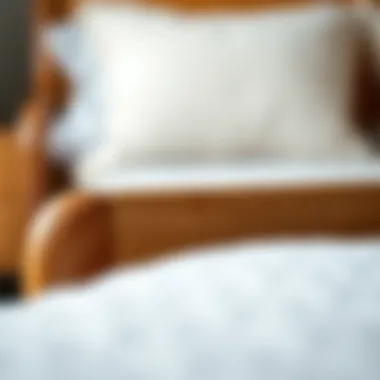

Just as vital as the wood itself, the finishes applied to wooden bed frames can make or break their longevity and aesthetic appeal. Finishes might enhance the wood’s natural colors or provide a protective barrier against scratches and moisture. Let's look into some common types:
- Oil Finishes: These penetrate the wood and bolster its natural beauty, allowing the grain to shimmer without a thick surface layer. Products like Tung oil or Linseed oil breathe well and protect the wood but may require reapplication over time.
- Lacquer: This finish creates a tough, high-gloss surface that’s resistant to scratches and easy to clean. However, it may obscure some of the wood’s natural character.
- Varnish: A go-to for a tough and glossy protective layer, varnish comes in various sheens from matte to high gloss. It can be great for those who prefer a refined look without sacrificing durability.
- Stains: Applying stains can dramatically change the appearance of wood, revealing a range of darker tones or enhancing grain patterns. This allows for greater personalization and can help match existing decor.
- Eco-Friendly Treatments: In recent times, more manufacturers are opting for plant-based or water-based finishes, which are better for both human health and the environment. These finishes achieve the necessary protection without harmful chemicals.
As with any design choice, it’s all about the balance. Combining the right type of wood with a thoughtful finish will elevate the bed frame while ensuring it integrates seamlessly with your individual context and style.
"The material is a crucial component of the total design; it speaks to the essence of the piece and enhances the overall experience of using it."
Being aware of materials and finishes leads to making an informed choice when selecting your wooden bed frame. The right combination not only improves safety and durability but also ensures that your bed speaks to your personal style.
Manufacturing Processes
When it comes to creating wooden bed frames, the manufacturing processes play a vital role in determining both aesthetics and functionality. Understanding the techniques employed in crafting these frames can significantly influence purchasing decisions for homeowners, decorators, and enthusiasts alike. Not only do these processes affect the durability of the final product, but they also contribute to the overall style and elegance that wooden bed frames with rounded corners can offer.
Traditional vs. Modern Techniques
Traditional techniques of crafting wooden bed frames often involve methods that have been passed down through generations. These techniques typically emphasize craftsmanship and attention to detail. Hand-cut joinery, for instance, is a hallmark of traditional furniture making, involving precise cuts that fit snugly without the need for glue or nails. This method not only provides a smooth aesthetic but also greatly enhances the durability of the frame.
On the other hand, modern techniques leverage technology to improve efficiency and consistency. CNC (computer numerical control) machines can cut and shape wood with extraordinary precision, allowing for more intricate designs, including those rounded corners that we appreciate so much. Measurements are taken digitally, ensuring there are fewer errors compared to manual methods. However, this can sometimes lead to a loss of the handcrafted charm that many consumers prefer.
Some benefits of each method include:
- Traditional Techniques:
- Modern Techniques:
- High durability through advanced joinery methods.
- Unique character and individual craftsmanship.
- Potential for customization by artisans.
- Faster production times at a larger scale.
- More consistent quality across multiple units.
- The potential for complex designs and precise measurements.
Quality Control Measures
In the world of wooden bed frames, quality control measures are essential for ensuring that every piece meets rigorous standards. Manufacturers typically implement a few crucial checks during the production process. These could range from inspecting raw materials to evaluating the durability of the finished products. Quality control also involves assessing the joinery features and finishes, ensuring they align with industry standards and consumer expectations.
Some important measures may include:
- Regular testing of wood strength and finish durability.
- Visual inspections for chips, cracks, and other blemishes.
- Measuring for exact dimensions to make sure every piece fits together seamlessly.
"Quality in a product or service is not what you put into it. It is what the customer gets out of it." – Peter Drucker
By adhering to rigorous quality control processes, manufacturers can guarantee that their wooden bed frames not only look good but also stand the test of time, offering both safety and reliability for users. This is particularly significant for bed frames with rounded corners, where the integrity of the frame is crucial to both aesthetic appeal and safety in any living space.
For more insights on the impact of manufacturing techniques in furniture design, check out Wikipedia or visit Britannica.
Benefits of Rounded Corners in Bed Frames
When choosing a bed frame, the design elements play a significant role in both aesthetics and practicality. The inclusion of rounded corners in wooden bed frames presents an array of benefits that address both aesthetic appeal and functional requirements. This section sheds light on the reasons why rounded corners are not just visually pleasing but also contribute to a safer and more efficient living space.
Space Efficiency and Arrangement
Rounded corners in bed frames can dramatically influence how a room feels and functions. First off, these designs can enhance space efficiency, allowing for a smoother flow in smaller rooms. Consider a bedroom that feels cramped; sharp corners can obstruct movement and accessibility. In contrast, rounded corners create a more open environment, helping to avoid those sharp angles that can make navigating tight spaces a hassle.
- Optical Illusion of Space: Rounded designs can trick the eye into perceiving a larger area than it is actually, giving a sense of openness that straight edges can't achieve.
- Flexible Arrangement: The ease of placement becomes apparent as there’s less need to worry about aligning everything perfectly. A bed with rounded edges can be positioned closer to walls or other furniture pieces without the fear of creating a tight and uncomfortable setup.
Think about it like this: it’s akin to rearranging your living room. A more flexible arrangement creates a relaxed vibe, and the same principle applies to your bedroom.
Child and Pet Safety
The safety of children and pets is paramount in any home, and wooden bed frames with rounded corners are often considered a smart choice for families. The inherent nature of rounded edges means fewer chances for accidents involving well-meaning but sometimes clumsy kids or rambunctious pets.
- Reduced Risk of Injury: Sharp corners can be a real hazard. A simple bump or fall against a standard bed frame could lead to serious injuries. Rounded corners significantly lower this risk, offering a gentler barrier in high-traffic areas within the room.
- Encouraging Playfulness: Young children often explore their surroundings in energetic ways. A bed with rounded corners not only fosters a safer environment for crawling and climbing but also encourages spontaneous play without parents constantly worrying about potential pitfalls.
Furthermore, for pet owners, the rounded design means less likelihood of injury during the happy chaos that pets inevitably bring into a home. This is particularly important for small breeds or curious kittens, who might dart around without a care in the world.
"Safety and style can coexist, and wooden bed frames with rounded corners embody both. They create a haven that’s not just beautiful but also secure for everyone in the family."
Design Styles Incorporating Rounded Corners
Wooden bed frames with rounded corners offer a unique blend of aesthetic charm and practical functionality that resonates across various design styles. The incorporation of these curves not only enhances the visual appeal but also serves critical purposes in modern interior design. As we explore different styles, it becomes clear that the design of a bed frame does more than support a mattress; it sets the tone for the entire bedroom environment.
Rounded corners soften the overall look of furniture, creating a welcoming and comfortable atmosphere. They can also contribute to a more fluid perception of space, especially in bedrooms where movement is frequent. The elegance embedded in such designs speaks to the discerning homeowner, enhancing the decorative elements within their living spaces.
Contemporary Designs
Contemporary designs make good use of rounded corners, presenting a sleek and minimalistic approach. Furniture in contemporary homes often focuses on clean lines and a balance between function and form. Round edges fit seamlessly into this philosophy, softening the sometimes harsh lines commonly found in minimalist setups.
This style embraces modern materials and aesthetics, incorporating smooth finishes and neutral palettes. For instance, a bed frame crafted from walnut or maple with rounded corners might be paired with understated bedding to create an airy, yet sophisticated feel. Such simplicity allows for the incorporation of bold decor elements—like colorful art or textured throw pillows—without the space feeling overcrowded.
Additionally, manufacturers are increasingly using engineered woods which lend themselves well to smooth, rounded designs, allowing for greater versatility in shape and size. Homeowners looking to infuse a modern touch can be assured that choosing a rounded corner frame can align perfectly with current trends.
Classic Aesthetics
On the flip side, rounded corners can invigorate classic aesthetics, offering a great interplay between traditional elegance and contemporary functionality. Here, the charm lies in how time-honored designs can incorporate softer edges. A classic four-poster bed, for example, can be elevated by gracefully rounded corners, lending a touch of gentleness to its otherwise imposing stature.
In many classic bedroom styles, wood is generally the primary material. Mahogany or cherry wood options are popular choices, enhancing the warmth and richness of the design. Historically, ornate carvings often adorned such pieces, but rounded corners shift the focus from intricate details to the very form of the bed itself.
The subtle transition from sharp to smooth provides a visual and physical comfort that resonates, creating a balance between the lavish and the refined. Rather than overshadowing existing décor, rounded corners complement and blend with quintessential elements such as vintage chandeliers or traditional woodwork, embodying a sophisticated style that appeals to both modern sensibilities and timeless tradition.
Rustic Influence
Rustic designs speak to the natural beauty that wood can offer, and frames with rounded corners can embody this ethos effectively. By utilizing raw or distressed wood, these frames celebrate imperfections and the character of materials sourced directly from nature. Rounded edges here soften the ruggedness often associated with rustic styles, providing a perfect juxtaposition.
Imagine a reclaimed wooden bed frame with well-worn, rounded edges; it tells a story of its origins while inviting comfort into the home. The rustic aesthetic typically leans toward earthy tones and organic textiles, making the integration of rounded corner frames a natural fit. This style thrives on pairing with complements such as woven linens, patterned quilts, and handmade crafts, which enhance its utterly laid-back vibe.
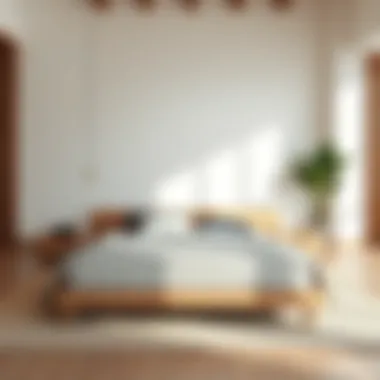
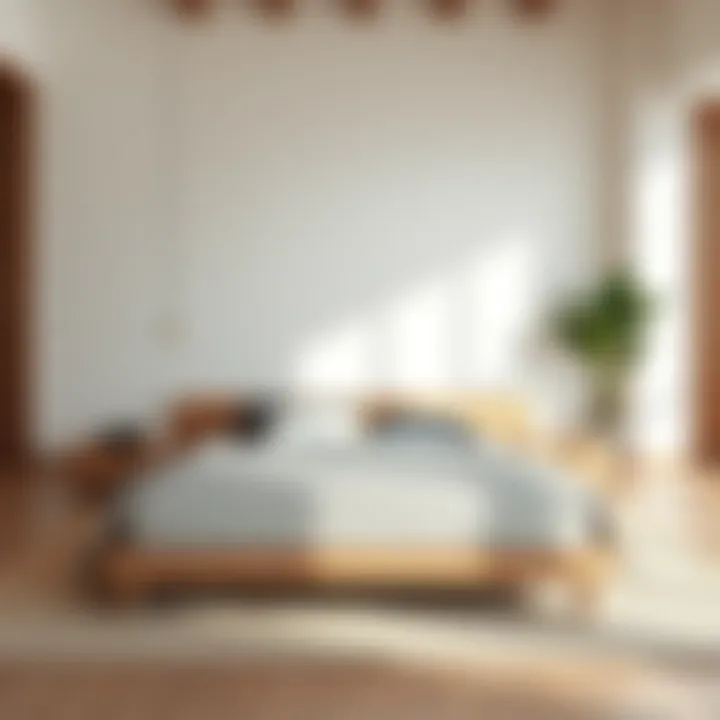
Moreover, incorporating rounded corners in rustic designs can enhance safety, especially in family environments. With children and pets often in play, the smooth edges help eliminate potential hazards while maintaining the rustic charm that draws many to this style.
Overall, whether through contemporary sleekness, classic richness, or a rustic touch, wooden bed frames with rounded corners reflect a keen understanding of the importance of design styles. These rounded elements are not merely an aesthetic choice; they intertwine function and beauty, rounding out a room's narrative with grace and consideration.
Customization Options
Customization options with wooden bed frames are not just an added bonus; they speak to the individuality of each homeowner. These options allow for the melding of aesthetics, functionality, and personal taste, ensuring that your bed frame isn’t merely a piece of furniture but a reflection of your personality and lifestyle. In today’s crowded market, where choices abound, customization can help one discern a unique identity within interior design, particularly when it comes to furniture like wooden bed frames with rounded corners.
Bespoke Design Elements
Bespoke design elements in wooden bed frames refer to the tailored features that can be specifically created to meet individual preferences. Whether it’s the precise curvature of rounded corners or the overall structural form, these elements can be crafted to match not only physical needs but also the visual texture of a home.
- Customized Dimensions: Many people overlook the fact that bedrooms come in various shapes and sizes, requiring beds that fit perfectly. Opting for a customizable bed frame means you can dictate the height and width, ensuring it fits snugly without compromising space.
- Personalized Bed Styles: From a clean minimalist frame to a more ornate design, each type offers distinct aesthetics. Homeowners might wish to explore styles such as a Scandinavian clean design or perhaps a rustic cabin style that leans into natural imperfections.
- Unique Corner Radius: Round corners don’t have to be uniform. Clients can decide on a smooth subtle curve or take a more pronounced approach, influencing the overall look and feel of the frame.
Bespoke options can cater to unique requirements, like adding built-in storage or ensuring the frame complements existing decor elements. In a way, customizing your bed frame is like establishing a signature look for your sleeping space.
Color and Finish Choices
When it comes to color and finish choices, the spectrum is virtually endless. This is where homeowners can play with tones and textures to enhance their bedroom’s ambiance. The right finish and hue can not only elevate a room's style but also offer practical benefits.
- Staining versus Painting: Opting for natural wood stains allows the grain to shine through, adding warmth, while a painted finish can introduce a modern flair or subtle elegance. Depending on the desired look, one could choose between deep mahogany stains for a classic allure or light pastels for a fresh, contemporary vibe.
- Matte vs. Glossy Finishes: This decision significantly influences both style and maintenance. Glossy finishes can impart a sense of sophistication and are easier to clean, yet they may scratch easier. On the other hand, matte finishes offer a more subdued look but can attract dust and scratches more noticeably.
- Eco-Friendly Options: With growing concerns about sustainability, many manufacturers now offer eco-friendly paints and stains. These alternatives not only reduce environmental impact but can also appeal to homeowners interested in greener living.
In summary, the significance of choosing the right color and finish transcends mere aesthetics. It’s about harmony with the rest of your home and the ease of upkeep over time. Properly selected finish can ensure that your wooden bed frame with rounded corners remains a centerpiece of beauty and practicality for years to come.
"The details are not the details. They make the design." – Charles Eames.
Customization options, from design to color choices, allow not just for the personalization of a bed frame but also enhance the overall integration into one’s personal style and living space.
Choosing the Right Bed Frame for Your Space
Selecting a bed frame might feel like just another chore on the home decor checklist, but it may very well be one of the most crucial decisions in shaping the overall ambiance of your bedroom. A bed frame isn’t merely a piece of furniture; it plays a pivotal role in your personal space. One of the key elements to consider here is size. A well-chosen bed frame should not only fit snugly into the room but also complement the existing elements without making the space feel cramped. Therefore, understanding your room dimensions is a vital first step to achieving harmony in your interior design.
Assessing Room Dimensions
Before pulling the trigger on any purchase, it’s imperative to take an accurate measure of your room. This might seem elementary, but considerable thought should be applied here.
- Measure Your Space: Start with length and width. Don’t forget about doorway clearance, especially if you're dealing with tight hallways or stairs.
- Listen to Your Space: Each room has a unique character. Bigger isn’t always better. An enormous king-size frame in a small room can feel out of place. Likewise, a tiny frame in a spacious setting may seem like an afterthought.
- Consider Mobility: Think about how you use the space day-to-day. A bulky frame might look stunning but can make it difficult to navigate around. You want to achieve a balance where the bed serves as a focal point without hogging all the attention or hindering movement.
Adapting your bed frame to your dimensions doesn’t just enhance aesthetics; it can massively affect functionality. A well-fitted frame can also create an illusion of spaciousness, making the room feel welcoming and organized.
Complementing Existing Decor
Once you’ve nailed down the size aspect, the next step involves tying the bed frame into your existing decor. In today’s fast-paced world, it’s tempting to choose a frame based on fleeting trends, but aiming for longevity means considering how well the frame interacts with your decor.
- Style Matching: Consider the overall design theme. A sleek, modern bed frame with rounded corners could clash if set against ornate Victorian furnishings. Balance is key.
- Color Coordination: Think hues that resonate. Neutral tones often play well across various palettes, while bold colors can serve as eye-catching centerpieces. Always consider how light affects the wood finish, either emphasizing warmth or coolness.
- Material Consistency: Hardwood frames pair naturally with other wooden elements in your room. A mismatched material can make things feel disjointed.
“A harmonious blend of design and functionality turns a simple bed frame into a sanctuary—making you feel cozy and at home.”
In short, choosing the right bed frame involves a mix of practical measurements and keen design sense. Each choice should be deliberate, impacting not just visual appeal but also the way you live in and enjoy your space. Whether you’re a homeowner looking to refresh your bedroom or a DIY enthusiast crafting ideas, remember that every aspect—from size to style—matters.
Maintenance and Care of Wooden Bed Frames
Maintaining and caring for wooden bed frames is not just about prolonging the life of your furniture; it is also an integral part of ensuring the aesthetic appeal and functionality of your bedroom space. Well-maintained wooden bed frames with rounded corners serve as focal points in modern interior decor, residing harmoniously in both minimalist and richly decorated rooms. The character that wood brings can't be overlooked, but such natural beauty requires attention. Regular care helps avoid issues that stem from neglect, such as scratches, warping, or discoloration. With an understanding of how to nurture your bed frame, you’ll ensure it lasts for years to come and retains its elegance.
Routine Cleaning Practices
Cleaning your wooden bed frame should be an integral part of your housekeeping routine. Dust and dirt can accumulate quickly, and this can dull the finish over time. Here are some practices that can help maintain its shine:
- Use a soft cloth: A microfiber cloth is ideal for regular dusting. Avoid rough fabrics that could scratch the surface.
- Damp wiping: For deeper cleaning, a slightly damp cloth can be used. Always follow up with a dry cloth to avoid water spots.
- Wood polish: Occasionally, a good wood polish can restore that luster. Look for products specifically made for wood; they often include conditioning oils that help keep the wood hydrated.
Important: Avoid excessive moisture as this can lead to wood swelling or mold growth.
"A little maintenance now saves a lot of repairs later!"
Long-term Preservation Tips
To keep your wooden bed frame in pristine condition over the long haul, consider these preservation tips:
- Avoid direct sunlight: Prolonged exposure to sunlight can bleach the wood, leading to uneven coloring. Use curtains or blinds to filter sunlight.
- Humidity control: Wood is hygroscopic, meaning it absorbs moisture from the air. In dry conditions, the wood may crack; conversely, excessive humidity can cause it to warp. Keep indoor humidity levels between 30-50%.
- Rotate your mattress: This not only prolongs the life of your mattress but also helps evenly distribute wear and tear on the bed frame.
- Inspect joints and screws: Periodically check for loose screws, especially in rounded corner areas where the structure may be under more pressure.
In summary, regular cleaning practices and proactive preservation measures are essential for maintaining the beauty and functionality of wooden bed frames. Paying attention to these aspects can enhance the longevity and aesthetic appeal of your bed frame, making it a valuable part of your home decor for many years.
Eco-Friendly Considerations
In an era where sustainability matters more than ever, the conversation surrounding eco-friendly considerations in furniture design is paramount. Selecting a wooden bed frame with rounded corners doesn't just revolve around aesthetics or functionality. It increasingly involves a commitment to environmental stewardship.
Sustainable Sourcing
When we talk about sustainable sourcing, it's necessary to look at where the wood comes from. This alludes to timber harvested from well-managed forests, where logging practices ensure that the ecosystem remains balanced. Sourcing from such places minimizes ecological degradation and promotes biodiversity.
Many brands now take a stand on transparency, offering products made from certified wood sourced from forests that prioritize sustainability, like those certified by the Forest Stewardship Council (FSC). By choosing beds from responsibly harvested materials, you not only contribute to reduced deforestation but also support local economies and communities involved in timber production.
"Choosing sustainable wood means more than just selecting a product; it reflects a lifestyle choice that respects nature's resources."
In addition to ethical sourcing, think about the lifespan of the bed frame. Durable, well-constructed frames made from sustainable wood tend to last longer. This longevity reduces waste, as there is less need to replace furniture constantly. Moreover, reclaimed wood options present a fantastic alternative, as they make use of timber that has already served a purpose, preventing it from ending up in landfills.
Biodegradable Finishes
No matter how eco-friendly the material, the finishes applied to wooden bed frames significantly influence their sustainability. Many conventional finishes and coatings contain harsh chemicals that can release volatile organic compounds (VOCs) into the air, posing not just environmental harm but health risks too. Opting for biodegradable finishes allows one to minimize this impact, as these products are typically derived from natural ingredients and break down without leaving toxic residues.
These biodegradable finishes range from natural oils and waxes to water-based lacquers that offer protection while being safer for the environment. Utilizing such finishes not only enhances the beauty of a wooden frame but also supports an individual’s intention to promote a healthier living space. Importantly, these products maintain the essence and authenticity of wood, often enhancing the grain rather than masking it with synthetic substances.
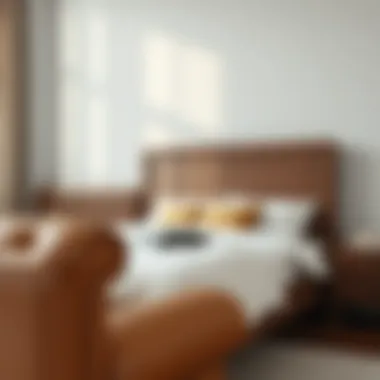
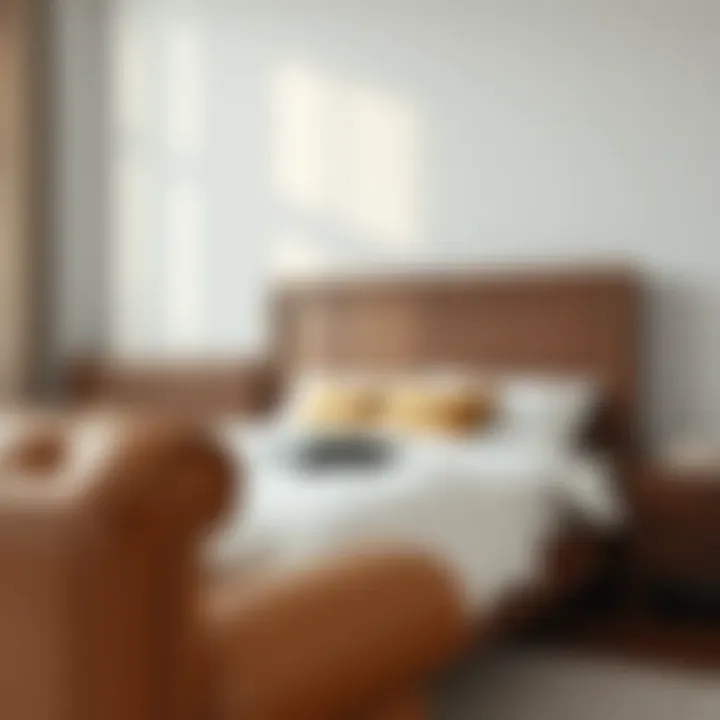
To sum it up, making choices that emphasize sustainable sourcing and biodegradable finishes reflects a growing awareness and responsibility toward ecological impacts. Not only do these considerations enhance the charm and functionality of wooden bed frames, but they also ensure that consumers can sleep soundly, knowing their purchase contributes positively to the planet.
Budgeting for a Quality Bed Frame
When it comes to selecting a wooden bed frame, especially one with rounded corners, budgeting plays a critical role that cannot be overlooked. A well-made bed frame is not just a piece of furniture; it’s an investment that affects the overall sleeping experience, aesthetics, and functionality in your bedroom. Understanding how to allocate your funds properly can make all the difference in ensuring that you get both quality and style without breaking the bank.
Before you delve into the myriad of options available, it’s helpful to set a budget that reflects your financial comfort level. This will prevent any buyer’s remorse down the line. Consider that you might not only be paying for the wood itself but also for craftsmanship, design, and lasting durability. In this case, opting for a wooden frame with rounded corners often entails a higher price tag due to the intricate construction methods involved. Nonetheless, the benefits may well justify the expense.
"Quality always costs a bit more in the beginning, but it saves in the long run."
Price Range Insights
The market for wooden bed frames is vast, with price points ranging widely based on factors like materials, design complexity, and brand reputation. Generally, you can expect:
- Budget Range: $300 - $600
- Mid-range: $600 - $1,200
- High-End: $1,200 and up
In the budget range, you might find frames made from softer woods like pine. Although economical, such frames may lack durability. Mid-range options often offer hardwood constructions, providing a balance between quality and affordability. High-end frames can be crafted from premium woods, and those designs typically feature intricate details and superior craftsmanship.
When considering price, don’t forget to factor in the cost of accessories like mattress compatibility, foundation needs, or decorative elements. Most cheaper options might skimp on details that can elevate the overall aesthetic, which can be particularly important given that rounded corners often communicate a softer, more inviting aesthetic.
Value vs. Cost Analysis
To truly understand the worth of your investment, it’s crucial to analyze value versus cost. A bed frame with a higher initial outlay can often yield more advantages in the long run through durability and style.
- Durability: Frames made from hard woods are resilient and withstand wear and tear better than their budget counterparts. Investing in a well-constructed piece may mean you won’t have to replace it annually.
- Resale Value: High-quality wooden frames maintain their value better over time, and you may find that you can recoup a percentage of your investment if you decide to sell or upgrade.
- Aesthetic Appeal: A rounded corner design often provides a contemporary look, enhancing your bedroom’s visual appeal. A frame that matches well with the existing décor can elevate the entire room.
In summary, the amount you’re willing to spend should reflect not just the initial cost but also these long-term advantages. By carefully assessing both the price and value, you can make an informed choice that aligns with your taste and lifestyle.
For those curious to delve deeper into materials and wood selection, resources such as Wikipedia or Britannica can offer valuable insights into the types of wood utilized in quality bed frames. Moreover, platforms like Reddit can provide real-world experiences from other homeowners or furniture enthusiasts.
Evaluating Designer Brands
When choosing a wooden bed frame, especially one with rounded corners, evaluating designer brands can make a significant difference in quality, aesthetic appeal, and functionality. Not all bed frames are created equal, and the nuances between different brands can affect both the aesthetics and longevity of the piece. Here, we will delve into the vital elements that constitute a reputable designer brand, emphasizing what to consider when making your choice.
Reputation and Craftsmanship
A brand's reputation often precedes it and speaks volumes about its craftsmanship.
Consider well-known brands like Thuma or West Elm; they’re often heralded not just for their designs but for how these designs are brought to life. Such reputation is typically built over years and often involves artisans who pour their skills and passion into each piece.
Brands focusing on high-quality craftsmanship often utilize traditional techniques that yield superior durability. For example, a handcrafted bed frame boasts better stability than mass-produced alternatives. This attention to detail can be seen in the way corners are rounded. It’s not simply about design; it’s about ensuring the right pressure is applied during manufacture to maintain form while avoiding sharp edges that can lead to injury.
- Look for certifications, such as FSC (Forest Stewardship Council), which indicates that the wood is sourced sustainably.
- Explore testimonials and past projects from the brand to gauge the consistency in their work and whether it reflects their advertised promises.
So when diving into the realm of designer brands, it's worth taking a moment to reflect on their reputational standing in the market and to read between the lines of consumer feedback.
Customer Feedback and Ratings
The voice of the customer can be a powerful lens through which to evaluate any brand. In the age of social media and online shopping, insights are available at our fingertips. Platforms such as Reddit or Facebook are treasure troves brimming with genuine customer experiences.
A helpful strategy is to look at both positive and negative reviews, as they often reveal patterns in quality and functionality. For example, customers might praise the aesthetic appeal of a CB2 bed frame, yet complain about the sturdiness over time.
- Ratings on sites like Wayfair or Amazon can also give a sense of overall satisfaction. Look for trends in comments regarding:
- Assembly difficulties
- Material quality
- Longevity of the design
“Reading reviews isn’t just about affirming your choices; it’s about preparing for potential pitfalls and ensuring you get the best bang for your buck.”
Furthermore, don't overlook professional reviews from design magazines or home decor blogs, as they often provide a curated take on brands that combines aesthetic and practical insights.
The Future of Wooden Bed Frame Design
The landscape of bedroom furniture is shifting, particularly when it comes to wooden bed frames with rounded corners. This part of the article serves as a lens through which we can glimpse the evolving preferences, innovations, and sustainability considerations shaping the future of these beloved sleep structures. As consumer tastes evolve and technology advances, understanding these trends becomes essential for anyone involved in home decor or furniture design.
Emerging Trends
As we look to the future, several key trends are gaining momentum within the realm of wooden bed frames.
- Minimalism: The aesthetic of simplicity continues to resonate. Frames that prioritize clean lines, accentuated by rounded corners, create a space that feels open and uncluttered.
- Sustainable Materials: Homeowners are increasingly prioritizing eco-friendliness. Frames crafted from reclaimed wood or sustainably sourced timber not only appeal to environmental consciousness but also add a unique character to every piece.
- Versatile Styles: Blending modern with traditional, designers are focusing on pieces that adapt to different decor styles. This means rounded corner frames are made to fit seamlessly into contemporary settings while still providing hints of classic craftsmanship.
- Multi-Functional Designs: Sleeping solutions are becoming more adaptive. Bed frames with storage options or convertible mechanisms are increasingly popular, catering to urban dwellers and those with limited space.
With these trends, designers have a wide canvas to explore creativity while ensuring functionality remains at the forefront.
Technological Innovations
The advancements in technology significantly transform how wooden bed frames are designed, manufactured, and sold. Here are some noteworthy innovations:
- Precision Engineering: Techniques like CNC (Computer Numerical Control) machining allow for increased precision in crafting rounded corners, ensuring a flawless finish that matches aesthetic desires and durability requirements.
- Customization Apps: Online platforms that enable buyers to visualize their designs facilitate a truly bespoke experience. Homeowners can select woods, finishes, and even dimensions, tailoring their bed frames to perfectly suit personal taste and room layout.
- Sustainable Production Techniques: New manufacturing processes minimize waste and reduce resource usage. Companies are increasingly adopting digital tools to optimize material consumption, thus creating more environmentally sustainable products.
- Smart Technology Integration: Emerging designs include integration with smart home systems. For instance, beds equipped with sensors that monitor sleep patterns can provide insights for improved rest.
These innovations not only enhance the aesthetic appeal of wooden bed frames with rounded corners but also address functionality and sustainability, aligning with the desires of modern consumers. The echoes of these changes will surely influence how sleep spaces are conceptualized, merging beauty with practical living.
Closure
As we wrap things up, it’s essential to take a moment to reflect on the nuances of wooden bed frames with rounded corners. This exploration just isn’t about aesthetics; it’s a deep dive into a thoughtful convergence of design, practicality, and safety that caters to a spectrum of preferences and needs. The choice of a bed frame is more than just a matter of personal taste; it’s an investment that can significantly affect the overall atmosphere and functionality of a bedroom.
Summarizing Key Points
Throughout our journey, we’ve uncovered several layers that make wooden bed frames with rounded corners stand out:
- Aesthetic Value: The curves lend a soft, inviting feel that can soften sharp lines in modern spaces, creating harmony in design.
- Functionality: Practical attributes include optimized space usage and safety, especially crucial for homes with children or pets.
- Variety of Styles: Whether it’s a contemporary minimalist look or a rustic charm, these frames mold to various decor styles effortlessly.
Moreover, the materials and finishes contribute to longevity and maintenance ease, making them not only beautiful but also durable. Each element—from wood type to design choices—plays a role in crafting a bed frame that meets individual preferences while enhancing the bedroom’s overall ambiance.
Final Thoughts on Wooden Bed Frames
In sum, selecting a wooden bed frame with rounded corners is about more than just furniture placement; it speaks to a lifestyle balance that values both beauty and utility. As we look ahead, trends evolve, yet the core principles of safety, durability, and style rinse through every innovation.
For homeowners, interior decorators, and design enthusiasts alike, investing in such a frame could mean embracing a blend of comfort, elegance, and thoughtful design. When making such a significant choice, it's wise to consider not only your immediate needs but also how these timeless pieces can contribute to your living space for years to come.
Whether you are in search of a standout centerpiece or a cozy retreat, wooden bed frames with rounded corners offer a striking solution that aligns form with function. Embracing these designs just might lead you down a path of discovering a new haven at home.



